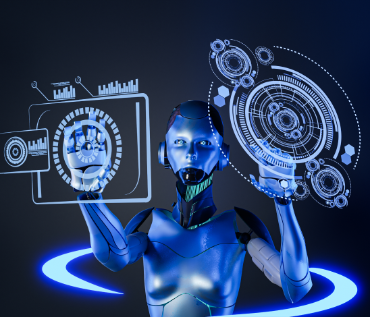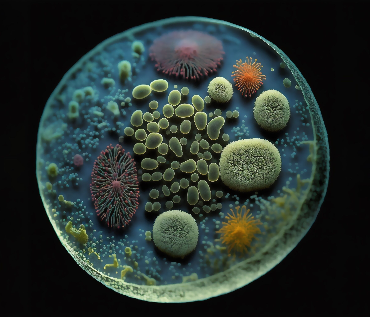Table of Contents
2. What is Automatic Microscopic Particle Classification?
3. Advantages Of Automatic Microscopic Particle Classification
4. Applications Of Automatic Microscopic Particle Classification
Introduction
Microscopic Particle Classification refers to studying the tiny particles under a microscope, which are generally invisible to the naked eye. From sample preparation to image capture to data analysis and decision-making, it is labor-intensive and prone to manual errors. Technological advancements have enabled the automation of the entire production process.
Automatic Microscopic Particle Classification automates the detection, analysis, and classification process. Smart machines assist scientists across various fields accelerate their research, which would otherwise take months or years to complete.
Times like COVID-19 have proved the need for automation to enhance production. The automatic classification of microscopic particles is emerging as a leading force, improving particle analysis efficiency and accuracy. This article discusses the techniques involved in automatic microscopic particle classification, their advantages, applications, and future.
What Is Automatic Microscopic Particle Classification?
Automatic microscopic classification is the automated categorization of particles observed under a microscope. The machine learning models and artificial intelligence classify the particles based on user-defined parameters. Images of the particles for analysis can be uploaded or acquired from microscopic imaging devices, encompassing a range from nanoparticles and cells to bacteria, APIs, and excipients.
The classification process relies on features such as size, shape, texture, and intensity. Thanks to the automatic method, which delivers accurate results within minutes, it is highly reliable and applicable across various scientific, medical, and pharmaceutical sectors.
Automatic microscopic particle classification leverages diverse deep learning architectures, including convolutional neural networks (CNNs), recurrent neural networks (RNN), long short-term memory, encoder-decoder, and generative adversarial networks (GANs). Once trained with datasets, these models can accurately classify a new micrograph within seconds. This automated approach is notably faster and more cost-effective than manual labor.
Check this video on the automatic particle size analyzer by ImageProVision technology.
https://www.youtube.com/watch?v=qNWd47b7hBY
Advantages Of Automatic Microscopic Particle Classification
There are several benefits of automating the process of microscopic particle classification, including Science, medicine, and industry. We discuss some of the advantages here:
a) Speed and Efficiency:
Rapid Analysis: The decision-making process becomes fast and easy as automation helps you process and analyze large datasets quickly.
High Throughput: Automated systems can handle a high volume of particles relatively quickly compared to humans, thus increasing overall efficiency.
b) Consistency and Objectivity:
Consistent Results: An Automated system produces consistent and reproducible results while eliminating any variations associated with manual analysis.
c) Handling Large Datasets:
Scalability: Since Automated systems can efficiently handle large and complex datasets, they are suitable for high-throughput applications and big data scenarios.
d) Customization and Adaptability:
User-Defined Parameters: The automation system allows users to define parameters and criteria for classification. Therefore, customization based on specific requirements is possible.
Adaptability: Since the types of particles the system detects depend on the training datasets, training with diverse datasets makes them versatile for various applications.
e) Accuracy and Precision:
Reduced Errors: As Automation reduces manual errors associated with manual classification, it can produce more accurate results.
Fine-grained Analysis: Advanced algorithms can precisely recognize subtle differences in particle characteristics that would otherwise be difficult for the human eye.
f) Cost-Effectiveness:
Resource Optimization: Automating the process reduces the need for extensive manual labor, ultimately saving costs associated with time and personnel.
Consistent Output: Consistent results eliminate the need to rework.
g) Real-Time Analysis:
Immediate Feedback: An Automated system can provide real-time feedback, allowing you to make prompt decisions. Real-time analysis holds high value in processes that require quick responses.
h) Versatility Across Industries:
Wide Applicability: Automatic particle classification applies to various industries, like pharmaceuticals, materials science, environmental monitoring, and more.
Multidisciplinary Use: The versatility of automated systems makes them a significant tool in several scientific and industrial domains.
i) Technological Advances:
Integration with Advanced Technologies: Automation can be integrated with advanced technologies like machine learning and artificial intelligence, enhancing classification capabilities.
Check this video to learn how to analyze SEM images using ImageJ software: https://www.youtube.com/watch?v=4xAKFYFABDI.
Applications Of Automatic Microscopic Particle Classification
Automatic microscopic particle classification has a vast range of applications across different fields. Here are some of the notable applications:
a) Medical Diagnostics — Using Automatic microscopic particle classification, you can detect microbes in medical samples and diagnose diseases like anemia and leukemia.
b) Environmental Monitoring — The automatic microscopic particle classification allows the detection of pollutants in air and water samples and aids in understanding pollution levels.
c) Material Science — Analysis of microscopic particles is important in studying material science to ensure purity and quality, especially in nanotechnology and metallurgy.
d) Pharmaceuticals — Hassle-free detection of any undesirable particle and quality check of the formulated drug across every batch using Automatic Microscopic Particle Classification.
e) Food Industry — Food products can have a variety of particles spanning from protein aggregates to individual nanoparticles, either added to improve food properties or derived from food contamination. These particles can be analyzed and classified rapidly with Automatic microscopic particle classification.
Check this video on the application of imaging particle analysis for environment monitoring.
https://www.youtube.com/watch?v=4EkJoOW4sBk
Future Trends
Technological advancements and the ongoing evolution of scientific research drive the future of automatic microscopic particle classification. In this section, we discuss the key trends and potential developments that may shape the future of microscopic particle classification:
1) Artificial Intelligence And Machine Learning:
Harnessing the power of Artificial Intelligence (AI) and Machine Learning (ML) algorithms for automated particle classification accelerates the process of research and development. Deep learning models like Convolutional Neural Networks are proving competent in identifying complex patterns and structures within microscopic images. The sophisticated technological advancements allow precise particle classification in diverse and intricate morphologies.
2) Multi-Modal Imaging Integration:
Data integration from multiple imaging modalities, such as atomic force, electron, and fluorescence microscopy, helps explicitly understand the particle characteristics. Merging data from different sources enables an extensive analysis, thus accurately enabling particle identification and classification.
3) Transfer Learning And Few-Shot Learning:
Transfer learning and few-shot learning methods address the challenge of restricted labeled datasets. Moreover, the experts can fine-tune pre-trained prototypes on tinier datasets, which makes it possible to accomplish reliable classification with limited labeled examples.
4) Real-time Analysis and Automation:
The future envisions real-time analysis along with automation. With high-speed imaging systems and refined algorithms, researchers and industries can rapidly analyze huge quantities of microscopic data, allowing quicker decision-making processes and enhanced efficiency.
5) Quantum Computing:
The springing up of quantum computing, which holds significant commitment for particle classification tasks, can be witnessed. Quantum computers can process huge amounts of data at the same time, and this way revolutionizes the computational aspects of microscopic particle analysis. It significantly reduces the processing times and expands the achievable extent.
6) Data Privacy and Ethical Considerations:
Data privacy and ethical considerations shall be major concerns with the advancements in AI and machine learning technologies. Moreover, data manipulation and mishandling would be something to worry about. As the utilization of AI continues to grow in sensitive domains of medical and pharmaceutical industries, the automation system providers need to focus on ensuring data privacy and its ethical use.
7) High-Throughput Analysis:
The advancements in hardware capabilities and parallel processing will allow systems to analyze large volumes of microscopic images. This feature would benefit pharmaceutical industries, environmental monitoring, and material sciences.
8) Enhanced Collaboration between Microscopy and Data Science Experts:
Experts in microscopy and data sciences will likely collaborate more, and this interdisciplinary approach can lead to the development of more robust and effective particle classification systems.
9) User-Friendly Interfaces and Accessibility:
With technological advancements, efforts to create user-friendly interfaces for researchers and technicians with every level of expertise to be able to utilize the automatic particle classification systems effectively.
10) Integration with Laboratory Information Systems (LIS):
We expect seamless integration with laboratory information systems for streamlining data management and analysis workflows. Data recording, analysis, and sharing are possible with a single click across the cloud for easy access.
Conclusion
Automatic microscopic particle classification helps researchers accelerate their research without compromising accuracy. Since automatization saves the time-consuming, labor-intensive work, it allows scientists to utilize their time in decision-making. The convergence of advanced imaging technologies, machine learning, and interdisciplinary collaborations shall shape automatic microscopic particle classification. These developments can potentially revolutionize particle analysis across various scientific and industrial domains.
Key Takeaways
- Integration of developed machine learning algorithms will improve accuracy in microscopic particle classes.
- Proceeding miniaturization of imaging devices will involve real-time, high-throughput analysis at the microscopic level.
- Automation and robotics will play a vital role in streamlining and speeding up particle classification.
- Emerging technologies such as quantum computing might revolutionize the computational elements of microscopic particle analysis.
- High collaboration between interdisciplinary fields, such as biology, computer science, and materials science, will drive innovations in automatic particle classification.
- Continuous research and development will pave the way for creating more sophisticated and versatile microscopic particle classification models.




